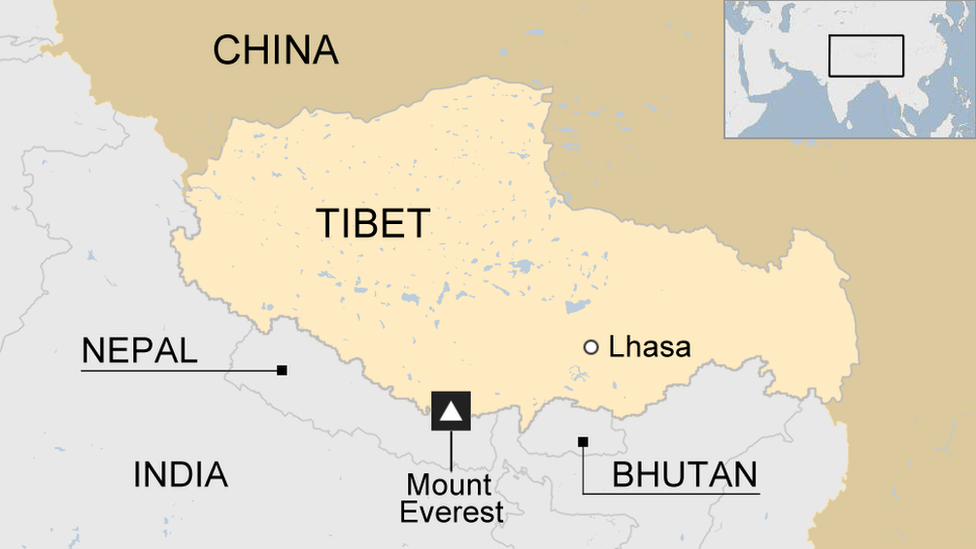China resettles two million Tibetans, says Human Rights Watch
- Published
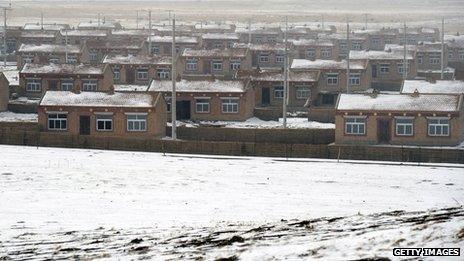
Human Rights Watch says that Communist officials are stationed in villages
More than two million Tibetans have been resettled by the Chinese government over the last seven years, a new report, external by Human Rights Watch says.
Many, including hundreds of thousands of nomads, were forced into so-called "socialist villages", the group says.
The aim is to exert tighter political control over ethnic Tibetans, says HRW.
China denies forced evictions. This comes amid reports that restrictions on the worship of the Dalai Lama have been eased in some areas.
But the BBC was unable to confirm claims that Buddhists in China's Tibetan areas were able to openly worship their exiled spiritual leader and that some temples were displaying portraits of him.
Closely monitored
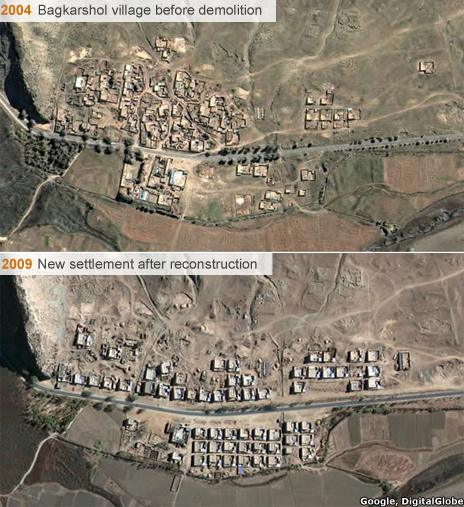
Images from Google Earth published by Human Rights Watch appear to show the mass destruction of existing housing and the construction of villages with uniform rows of new buildings.
"The government has started to despatch new teams of Communist Party officials to each single village of the Tibet Autonomous Region," explained Nicholas Bequelin, Asia Researcher with Human Rights Watch.
"The new personnel stationed in these villages have been instructed to eat, live and work with the villagers and that includes monitoring their political opinions and identifying whose loyalty to the Party or the government is questionable."
The Chinese government has consistently maintained that it is pouring billions of dollars into Tibet in order to bolster its economy and improve the Tibetans' way of life.
However, tensions remain. In the past four years, at least 117 Tibetans have set themselves on fire to protest at Chinese government rule, resulting in 90 deaths.
Many Tibetans resent the influx of Han Chinese into Tibet and the Communist Party's restrictions on their religious freedoms.
In response, the Chinese government has tightened surveillance over the entire Tibetan plateau. In cities, the authorities appear to be keeping tabs on potential troublemakers by dividing each neighbourhood along a grid system.
The new security system is designed to closely monitor the situation at street-level to prevent a repeat of mass protests that centred in Lhasa, the capital of Tibet, in March 2008.
In addition, the report says, about 300,000 nomadic herders have been relocated and settled since the early 2000s and the authorities have reportedly announced their intention to turn an additional 113,000 into sedentary dwellers by the end of 2013.
Open worship?
In a separate development, some Buddhists in China's Tibetan areas are now able to openly worship their exiled spiritual leader, the Dalai Lama, according to Radio Free Asia. In an experimental change in policy, some temples can openly display portraits of the Dalai Lama and no one is allowed to criticise him.
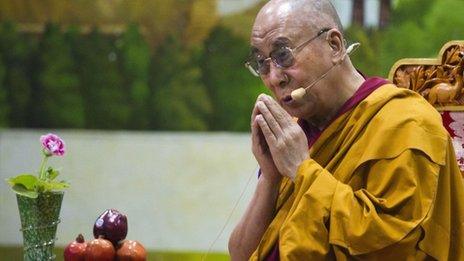
Unconfirmed reports suggest the Communist Party has relaxed its attitudes towards the Dalai Lama
Tibetan Buddhists are allowed to worship their leader in his role as a religious figure and not a political one, according to sources quoted by RFA.
If this policy change is true, it could represent a significant relaxation of the Communist Party's attitudes towards the Dalai Lama.
For years, senior Communist officials have infuriated Tibetan Buddhists by referring to the Dalai Lama by a series of derogatory names. Zhang Qingli, the Communist Party chief in charge of Tibet until 2011, famously referred to the Buddhist cleric as "a wolf in monk's robes".
Still, it is far from clear whether an experimental policy is under way. And some analysts say that, if true, it may simply be because the authorities had failed to stamp out worship of the Dalai Lama and use of his image in monasteries.
The BBC contacted the Communist Party's State Administration for Religious Affairs, headquartered in Beijing, for confirmation of this change in policy.
The administration did not respond to the BBC's repeated requests for comment. China's state-run media are also silent on a possible change of policy towards the Dalai Lama.
One source at a Buddhist temple in Qinghai province said that he had heard about the change in policy but could not speak about it on the telephone. The source refused to give his name.
A spokesperson for the Central Tibetan Administration, the Tibetan government in exile based in Dharamshala, India, said he had heard reports of the experimental policy, but had not been able to verify its existence.
"Such reports, if true, are localised reports," notes Tashi Phuntsok, secretary for the department for information and international relations for Tibet's government-in-exile. "It is possible some areas have adopted a softer policy to prevent further self-immolations."
"I've seen similar news online," one monk in Sichuan's Ganzi Prefecture told the BBC by phone. "I don't know if it is true or not. But it's certainly not happening here."
Another monk in Sichuan's Aba Prefecture, where many of the self-immolations have taken place, admitted: "I have not heard of this news. But we cannot hang the Dalai Lama's portrait inside the monastery or worship him openly.
"We can only do it in secret. Not in our monastery, not in the monastery around here either, not that I know."
- Published24 November 2012
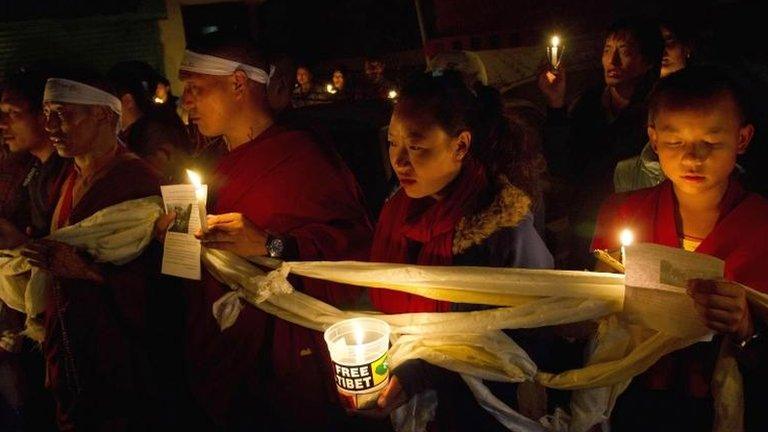
- Published12 November 2012

- Published27 September 2012
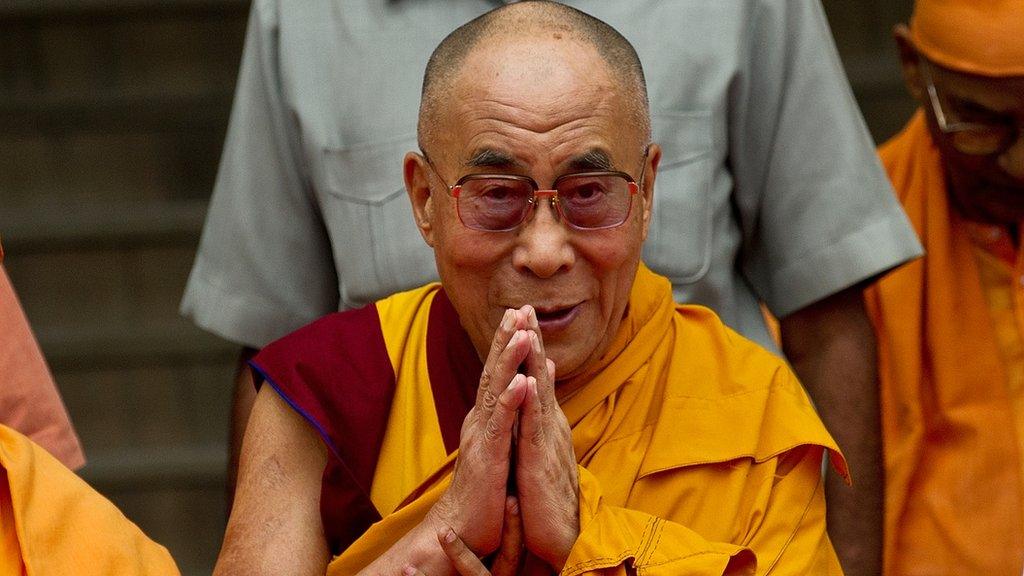
- Published27 January 2012
- Published7 January
